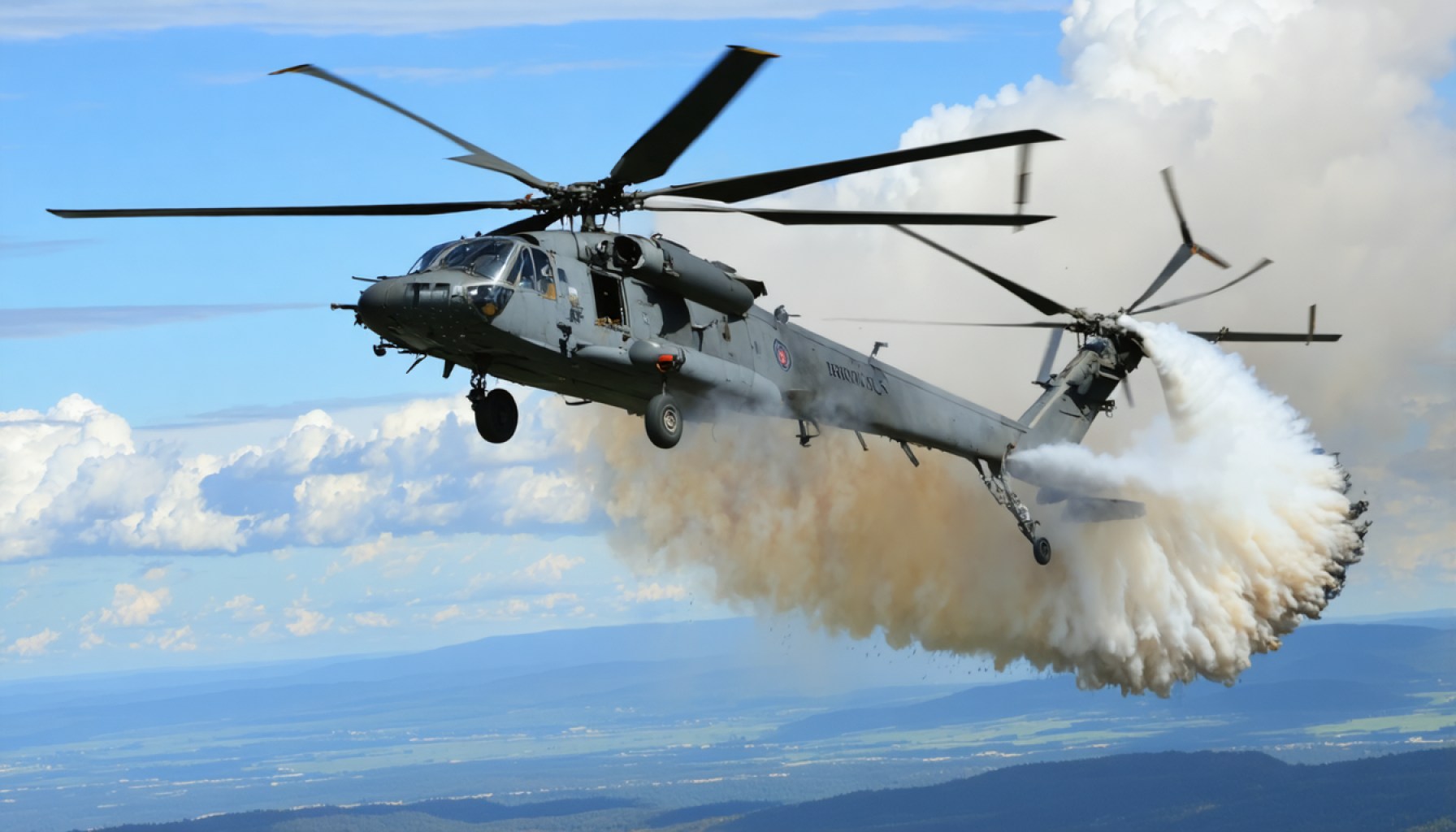- Virginia National Guard completed an aerial fire suppression training using UH-60 Black Hawk helicopters at Fort Barfoot.
- Crews from the 2nd Battalion, 224th Aviation Regiment used large water buckets to manage a prescribed burn with precision.
- The exercise was a collaborative effort between Fort Barfoot Fire and Emergency Services and the Natural Resources Division, conducted on March 12.
- Colonel Craig Lewis highlighted the exercise’s role in enhancing aircrew proficiency and emergency service collaboration.
- Aerial fire suppression requires significant coordination and mastery of technology, ensuring safe and efficient operations.
- Edwin Foster emphasized the importance of training in controlled settings to prepare for real wildfire events.
- The training exercise helped improve communication strategies for effective wildfire response.
- The Virginia National Guard remains ready to protect forests from fire through strategic training and dedication.
Amid the whispering pines and rolling landscapes of Fort Barfoot, a vivid drama unfolded in the sky. Virginia National Guard aviation crews, manning the formidable UH-60 Black Hawk helicopters, elegantly danced with the elements as they completed a critical training mission in aerial fire suppression. These skilled aviators, part of the 2nd Battalion, 224th Aviation Regiment, skillfully wielded their helicopters, each equipped with large water buckets, drenching the flames in a meticulously controlled prescribed burn.
Managed with precision by Fort Barfoot Fire and Emergency Services alongside the Natural Resources Division, the burn on March 12 demonstrated the seamless synergy necessary for such operations. Against this backdrop, their mission unfolded like a symphony, with each element tuned to perfection for safety and efficiency. As the crackling fire met its match from above, the crews honed their skills in a practice scenario that promised to prepare them for the real thing.
Colonel Craig Lewis, a steadfast presence within the Virginia National Guard as the State Army Aviation Officer, emphasized the exercise’s significance. Such exercises, he noted, serve as a vital conduit for enhancing the proficiency of aircrews while building the bridge of collaboration with emergency services, a key factor when responding to domestic fires that can blaze ominously through landscapes.
Aerial fire suppression is an endeavor as complex as it is essential, requiring not only mastery of technology and machinery but expert coordination among all teams involved. The power of the helicopters, expertly managed, along with rigorous training and collaboration, keeps these missions seamless and safe. Those at the helm of Black Hawks are not merely pilots; they are guardians of the forests, sentinels ready to respond when nature’s fury flares.
Edwin Foster, spearheading the Wildland Fire Program at Fort Barfoot, underscored the value of these exercises in a controlled setting. With roughly 4,000 sprawling acres still in need of cleansing fire this season, the necessity for meticulous training was evident. Crews practiced water drops amidst live flames, a rehearsal far more manageable and informative than the chaotic clamor of a real wildfire event.
From these smoldering exercises emerged profound insights into the rhythm of emergency responses—communication dances carefully choreographed to ensure no misstep in timing. The exercise was not merely about practicing drops but about understanding the symphony of response that helicopters might perform were calamity to strike the very heart of Fort Barfoot’s wilderness.
This chapter of training is now closed, but for the Virginia National Guard and their partners, the story continues to evolve. They guard the skies with watchful eyes, ever ready to rise and drench the fires that threaten. Through strategic training and relentless dedication, they assure us that the battle against wildfires will be waged with precision and valor. The skies, under their vigilant watch, promise calm in the face of the fiery storm.
Unveiling the Hidden World of Aerial Fire Suppression: What You Need to Know
Exploring the Complex World of Aerial Fire Suppression
The recent training exercise by the Virginia National Guard’s aviation crews at Fort Barfoot reveals the intricacies of aerial fire suppression, a critical service in emergency management. This operation involved the use of UH-60 Black Hawk helicopters, equipped with water buckets, to conduct a prescribed burn, showcasing their readiness to combat real wildfires effectively.
How-To: Mastering Aerial Fire Suppression
1. Training and Coordination: Critical for mission success is rigorous training that emphasizes coordination between helicopter pilots, ground crews, and emergency services. Simulation and live fire exercises are integral to building muscle memory for real operations.
2. Equipment Mastery: Pilots must be adept at handling the helicopter’s capabilities and limitations, mastering the use of fire buckets for precise water drops.
3. Communication: Implement a clear, structured communication system to ensure synergy among aerial and ground teams, a factor emphasized during the Fort Barfoot exercise.
Real-World Use Cases
Aerial fire suppression plays a pivotal role beyond controlled burns, addressing wildfires in locations difficult for ground-based firefighters to access. Urban interface fires and forest wildfires are primary scenarios where this method provides strategic advantages.
Industry Trends and Market Forecast
According to recent industry analyses, the global aerial firefighting market is projected to grow significantly, with advancements in aircraft technology and the development of new firefighting solutions being key drivers. See a broader picture of trends at Global Fire Events.
Reviews & Comparisons
Pros:
– Efficiency: Rapid response and ability to reach remote areas.
– Effectiveness: High-volume water delivery over fire hotspots.
– Safety: Reduces the risk to ground personnel.
Cons:
– Cost: High operational and maintenance costs.
– Weather Dependency: Limited by adverse weather conditions.
– Complexity: Requires well-planned logistics and coordination.
Security & Sustainability
The use of aerial fire suppression contributes to both immediate and long-term ecosystem management, promoting health and regrowth in forested areas through controlled burns.
Commonly Asked Questions
How do aerial water drops work?
Helicopters like the UH-60 Black Hawk utilize Bambi Buckets, which are mounted beneath the aircraft and can hold hundreds of gallons of water, strategically releasing this to extinguish fires.
What is a prescribed burn?
Prescribed burns are controlled fires set intentionally to manage forest ecosystems, reduce excess vegetation, and prevent larger wildfires.
Actionable Recommendations
– Emergency Services: Cultivate partnerships with local fire services to enhance response preparedness.
– Continuous Training: Maintain regular simulation exercises to stay adept with the latest firefighting techniques.
– Technology Investment: Invest in newer aircraft and equipment to improve fire suppression capabilities.
Conclusion
The operations at Fort Barfoot are a testament to the expertise and coordination required for successful aerial fire suppression. As the threat of wildfires increases, strategic training and advanced technology remain crucial in ensuring that our natural landscapes are protected efficiently and safely. For more information on this subject, visit the National Guard website.



